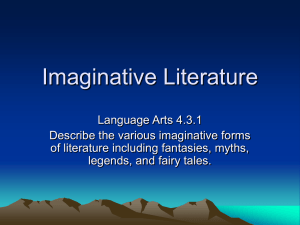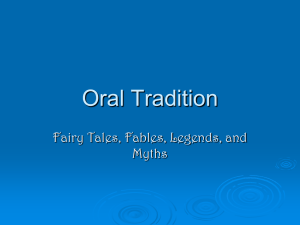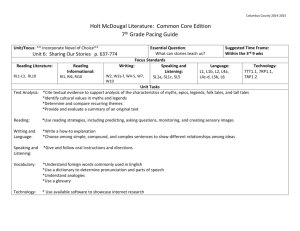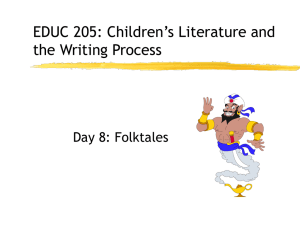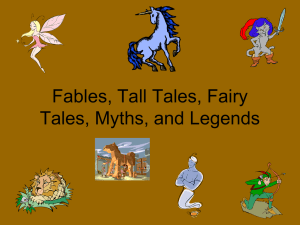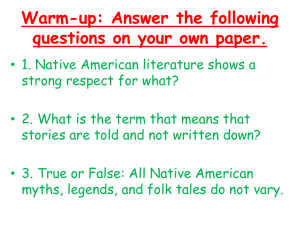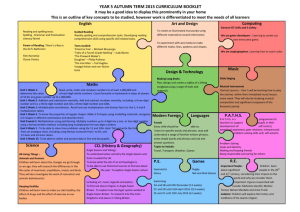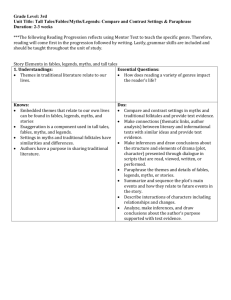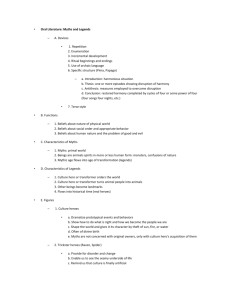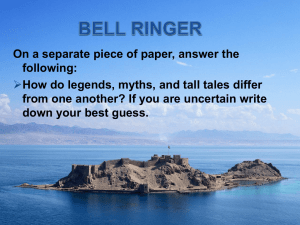Writing Ideas
advertisement
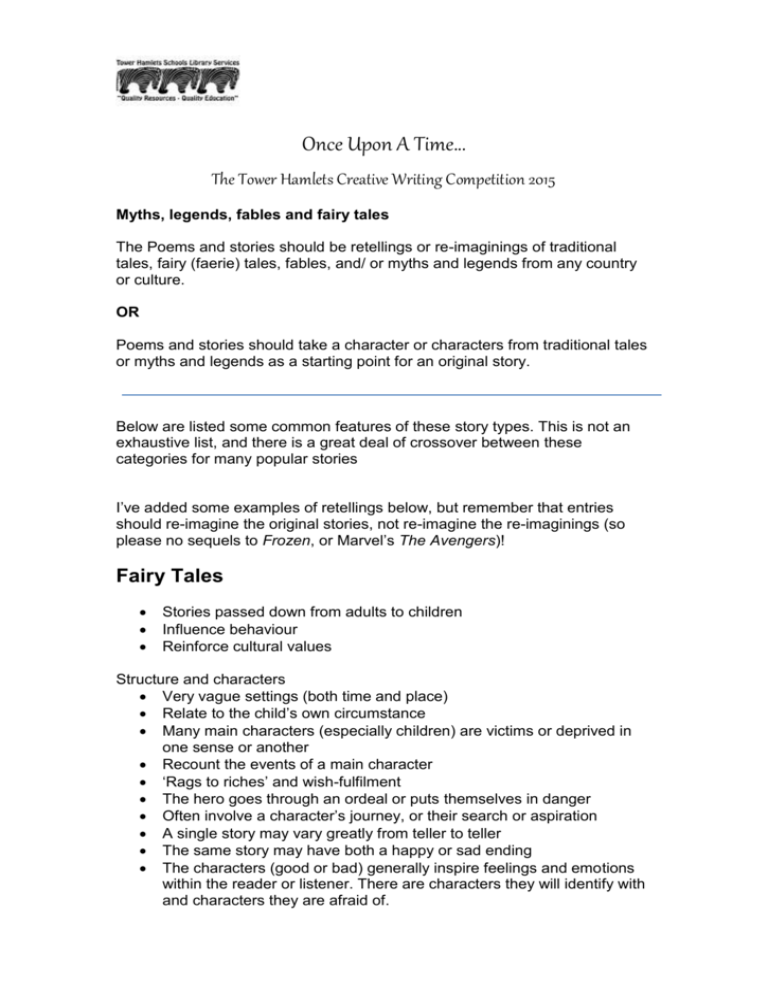
Once Upon A Time… The Tower Hamlets Creative Writing Competition 2015 Myths, legends, fables and fairy tales The Poems and stories should be retellings or re-imaginings of traditional tales, fairy (faerie) tales, fables, and/ or myths and legends from any country or culture. OR Poems and stories should take a character or characters from traditional tales or myths and legends as a starting point for an original story. Below are listed some common features of these story types. This is not an exhaustive list, and there is a great deal of crossover between these categories for many popular stories I’ve added some examples of retellings below, but remember that entries should re-imagine the original stories, not re-imagine the re-imaginings (so please no sequels to Frozen, or Marvel’s The Avengers)! Fairy Tales Stories passed down from adults to children Influence behaviour Reinforce cultural values Structure and characters Very vague settings (both time and place) Relate to the child’s own circumstance Many main characters (especially children) are victims or deprived in one sense or another Recount the events of a main character ‘Rags to riches’ and wish-fulfilment The hero goes through an ordeal or puts themselves in danger Often involve a character’s journey, or their search or aspiration A single story may vary greatly from teller to teller The same story may have both a happy or sad ending The characters (good or bad) generally inspire feelings and emotions within the reader or listener. There are characters they will identify with and characters they are afraid of. Clearly defined heroes and villains of the story Similar stereotypes to fables (the evil witch, the wise old helper, the comic foil) The hero from the real world often either encounters a magic world or character, or the hero strays into a dangerous magical world The same or similar stories can be found in many different cultures and can be used to explore cultural differences Language Strong use of pattern and repetition. For example sequences of predictable events, or frequent use of a rhyme or magic song. Memorable lines, e.g. “Fe Fi Fo Fum!” “Granny, what big teeth you have!” Familiar phrases: “Once upon a time...” “Long ago and far away…” Characters will have different modes of speech depending on who or what they are. For example magical creatures may speak only in rhyme or use antique speech or slang. Monsters and giants may use lots of shouts and roars Imagine the story being read aloud using the different voices. Make it fun! Examples Red Riding Hood Cinderella The Three Little Pigs (shares elements of a fable) The Gingerbread Man Hans Christian Anderson stories Examples of alternative retellings M is For Magic (Neil Gaiman) King and King The Wolf’s tale The true story of the Three little pigs The Korean Cinderella Fables Teach important life lessons in an amusing way Structure Often very short – even just a page long Often comprise of a complication and a resolution The resolution may have a twist to it, or not be what one of the characters – or even the reader – expects. Often concerns just two main characters, one of whom is taught a life lesson by the other Animals are often the main characters Animals often represent human stereotypes such as laziness, aggression, wisdom and cunning. Matching the animal’s physical characteristic to the behaviour The characters usually lend their names to the title There is always a clear moral at the end Language Dialogue is used to advance the plot and explain the moral The setting and characters are established without fuss Characters remain as stereotypes with no back story or explanation of how they got here. Use of cause and effect Fables are very suited to humour Examples The Scorpion and the Fox The Tortoise and the Hare Most Anansi Stories Examples of alternative retellings The Stinky Cheese Man Myths Provide fictional explanations for how the world is, such as creation myths Pass on cultural or spiritual beliefs Structure and characters: Set in an unspecified point in time, but usually the distant past Presented as a true history Often feature a journey, quest, or series of trials or ordeals (literal or spiritual) Feature characters with superhuman or magical abilities – from gods, demi-gods and heroes, to talking animals Feature fantastic monsters and impossible creatures Can feature ‘normal’ characters whose lives are influenced or changes by superhuman characters Can pass on a moral, message or have a deeper meaning Can have a tragic ending Characters often have flaws that are explored in the stories Often ambiguous morality – even the heroes may act questionably Characters are often at the mercy of higher powers such as fate, or the gods The actions of the characters almost always have far-reaching consequences Language Rich and expressive Dialogue is limited and functional Vivid descriptions of fantastic characters, creatures and settings Lots of description and fast-paced action Use of symbolism Traditional Examples Greek myths such as Perseus and Medusa Norse tales such as the story of Ragnarok Dreamtime stories from Australia Examples of alternative retellings The Sandman series by Neil Gaiman Various Superhero stories Legends Blend elements of the truth or historical facts with mythology Pass on beliefs, ideas and ideals Teach us about the past in an exaggerated way Structure and characters Usually set in a specific place and time The chronicles of a hero’s life and deeds The hero can have mythological, or near superhuman qualities – the stories may be based upon the lives of real people but their powers and deeds will have become exaggerated over the centuries as the stories have been changed by each storyteller. For example; Robin Hood’s skill with a bow, Aladdin the master thief, Sinbad the great sailor. Mythological creatures such as dragons may still exist in these times Can involve quests for, or the use of, magical artefacts. For example the sword Excalibur, the grail/ cauldrons/ treasures of Britain, magic lamps and flying carpets. The reader should care about the central character Clearly defined heroes and villains The characters’ fates are often defined by historical realism. Where are the dragons, magic and legendary cities today? Legends often end with cities like Atlantis sinking beneath the sea, magic being lost or sealed away. Legendary characters often do not die, but (like King Arthur) are taken away into a mythological land with the promise that they will return Language and writing Rich vocabulary and dialogue Similes and metaphors Symbolism (for example use of colours, light and dark, weather and seasons) Historical accuracy (to a point) Examples Robin Hood King Arthur Beowulf 1001 Arabian Nights
